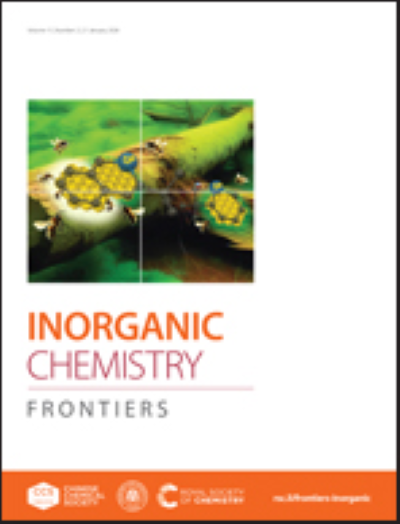A superparaelectric design with structure optimization enables superior energy-storage performances and stabilities in (Na0.5Bi0.5)TiO3-based ceramics
IF 6.1
1区 化学
Q1 CHEMISTRY, INORGANIC & NUCLEAR
引用次数: 0
Abstract
Lead-free (Na0.5Bi0.5)TiO3-based dielectric materials are promising for electrostatic energy storage due to their strong polarization response and environmental friendliness. However, challenges like high electric hysteresis loss (Wloss) and low electric breakdown strength (Eb) limit their recoverable energy density (Wrec) and energy conversion efficiency (η). A superparaelectric design with structure optimization has been proposed to overcome these restrictions. Based on this strategy, a series of (1 − x)(Na0.3Bi0.38Sr0.28)TiO3–xCa(Ta0.2Ti0.75)O3 (abbreviated as (1 − x)NBST–xCTT; x = 0.0, 0.1, 0.2, 0.3, and 0.4) ceramics were fabricated. Their phase structure gradually evolves from the rhombohedral and tetragonal coexistence (R&T) to the tetragonal and cubic coexistence (T&C), accompanied by the increasing proportion of weakly coupled and highly dynamic polar structures. This behavior enables the establishment of a superparaelectric relaxor ferroelectric (SPE-RFE) state, reducing Wloss, enhancing η, and improving dielectric stability. The improved microstructure with refined grains boosted Eb, further contributing to excellent performances. Notably, the optimized 0.6NBST-0.4CTT SPE-RFE ceramic, with high Eb, large polarization difference (ΔP), and slight Wloss, delivered a large Wrec of 6.90 J cm−3 with a high η of 92.55% at 600 kV cm−1, alongside excellent dielectric stability (−60 to 135 °C) following the EIA-X7R standard. Moreover, a high power density (∼125 MW cm−3) and an ultrafast charge–discharge rate (t0.9 ∼ 33 ns) were realized at 300 kV cm−1. Encouragingly, the 0.6NBST-0.4CTT SPE-RFE ceramic also exhibits excellent energy-storage/charge–discharge stabilities. These results highlight the promising potential of the 0.6NBST–0.4CTT SPE-RFE ceramic for electrostatic energy storage. They also confirm the effectiveness of this strategy and provide valuable guidance for advancing dielectric energy-storage materials/capacitors.

一种结构优化的超准电设计使(Na0.5Bi0.5) tio3基陶瓷具有优异的储能性能和稳定性
无铅(Na0.5Bi0.5) tio3基介电材料具有极化响应强、环境友好等优点,在静电储能领域具有广阔的应用前景。然而,高电迟滞损耗(Wloss)和低电击穿强度(Eb)等挑战限制了它们的可回收能量密度(Wrec)和能量转换效率(η)。为了克服这些限制,提出了一种结构优化的超超电设计方法。基于该策略,制备了一系列(1−x)(Na0.3Bi0.38Sr0.28) TiO3-xCa (Ta0.2Ti0.75)O3(缩写为(1−x) NBST-xCTT;X = 0.0, 0.1, 0.2, 0.3, 0.4)制备陶瓷。它们的相结构由菱形与四方共存(R&;T)逐渐演变为四方与立方共存(T&;C),并伴随着弱耦合和高动态极性结构的比例增加。这种行为使得超准电弛豫铁电(SPE-RFE)状态的建立,降低了Wloss,提高了η,提高了介电稳定性。晶粒细化后的组织提高了Eb,进一步提高了材料的性能。值得注意的是,优化后的0.6NBST-0.4CTT SPE-RFE陶瓷具有高Eb,大极化差(ΔP)和轻微的Wloss,在600 kV cm - 1时,具有6.90 J cm - 3的大Wrec和92.55%的高η,并且具有优异的介电稳定性(- 60至135°C),符合EIA-X7R标准。此外,在300 kV cm - 1下实现了高功率密度(~ 125 MW cm - 3)和超快充放电速率(t0.9 ~ 33 ns)。令人鼓舞的是,0.6NBST-0.4CTT SPE-RFE陶瓷也表现出优异的储能/充放电稳定性。这些结果突出了0.6NBST-0.4CTT SPE-RFE陶瓷在静电储能方面的巨大潜力。他们也证实了这一策略的有效性,并为推进电介质储能材料/电容器提供了有价值的指导。
本文章由计算机程序翻译,如有差异,请以英文原文为准。
求助全文
约1分钟内获得全文
求助全文
来源期刊

Inorganic Chemistry Frontiers
CHEMISTRY, INORGANIC & NUCLEAR-
CiteScore
10.40
自引率
7.10%
发文量
587
审稿时长
1.2 months
期刊介绍:
The international, high quality journal for interdisciplinary research between inorganic chemistry and related subjects
 求助内容:
求助内容: 应助结果提醒方式:
应助结果提醒方式:


